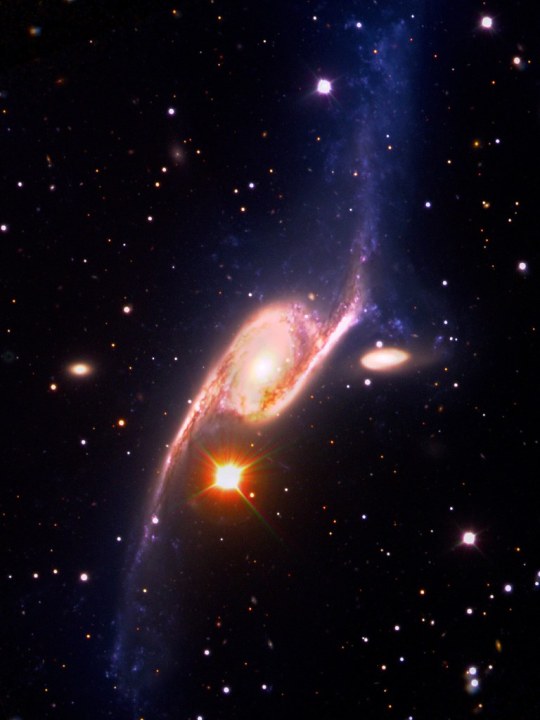#ngc 6872
Text
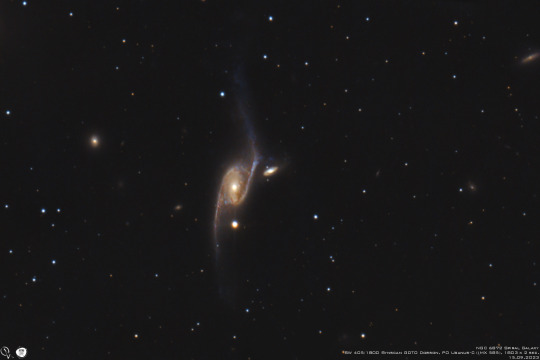
The Condor Galaxy, NGC 6872 // Mirosław Stygar
#astronomy#astrophotography#galaxy#spiral galaxy#barred spiral galaxy#star-forming galaxy#peculiar galaxy#interacting galaxies#condor galaxy#NGC 6872#IC 4970#pavo
21 notes
·
View notes
Text

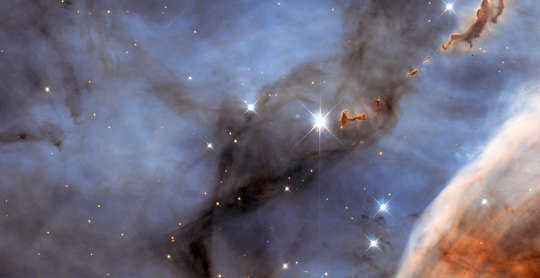


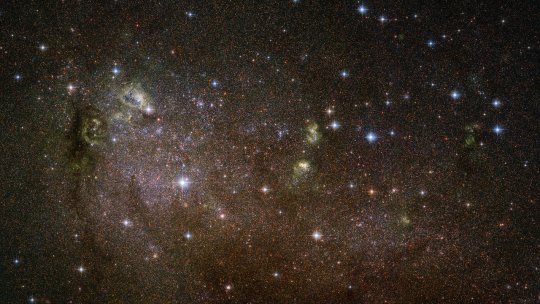
NGC 3324, Cosmic Cliffs
Carina Nebula, Mystic Mountains
NGC 6872 & IC 4976
M31, Andromeda Galaxy
IC 10
#stars#space#celestial#cosmic#cosmos#nebula#galaxies#cosmic cliffs#astral#andromeda#beautiful#beauty#escape#pretty#astrophotography#deep space#galactic#starburst galaxy#space dust#photography#carina nebula#ngc 3324#ngc 6872#ic 4976#ic 10#outer space#gorgeous#mesmerizing#nature#the unknown
555 notes
·
View notes
Photo

2023 June 23
Giant Galaxies in Pavo
Image Credit & Copyright: Mike Selby, Observatorio El Sauce
Explanation: Over 500,000 light years across, NGC 6872 (top right) is a truly enormous barred spiral galaxy, at least 5 times the size of our own very large Milky Way. The appearance of this giant galaxy's distorted and stretched out spiral arms suggests the magnificent wings of a giant bird. Of course its popular moniker is the Condor galaxy. It lies about 200 million light-years distant toward the southern constellation Pavo, the Peacock. Lined with star-forming regions, the distorted spiral arms are due to NGC 6872's gravitational interaction with the nearby smaller galaxy IC 4970, seen just above the giant galaxy's core. The Pavo galaxy group's dominant giant elliptical galaxy, NGC 6876 is below and left of the soaring Condor galaxy.
∞ Source: apod.nasa.gov/apod/ap230623.html
75 notes
·
View notes
Photo

An Interacting Colossus: NGC 6872 by NASA Hubble
309 notes
·
View notes
Text
The giant barred spiral galaxy NGC 6872 is 522,000 light-years across, More than five times the size of the Milky Way galaxy.
Credit: NASA/ESO/JPL-Caltech/DSS
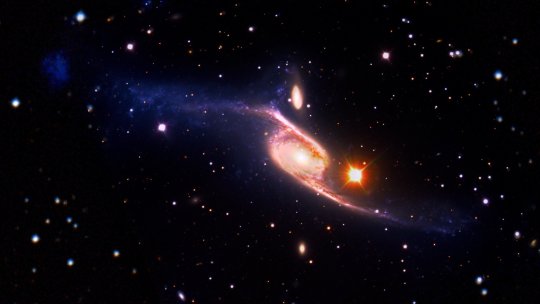
20 notes
·
View notes
Text
Giant Galaxies in Pavo

Over 500,000 light years across, NGC 6872 (top right) is a truly enormous barred spiral galaxy, at least 5 times the size of our own very large Milky Way. The appearance of this giant galaxy's distorted and stretched out spiral arms suggests the magnificent wings of a giant bird. Of course, its popular moniker is the Condor galaxy. It lies about 200 million light-years distant toward the southern constellation Pavo, the Peacock. Lined with star-forming regions, the distorted spiral arms are due to NGC 6872's gravitational interaction with the nearby smaller galaxy IC 4970, seen just above the giant galaxy's core. The Pavo galaxy group's dominant giant elliptical galaxy, NGC 6876, is below and left of the soaring Condor galaxy.
Image Copyright: Mike Selby
0 notes
Text

APOD: Giant Galaxies in Pavo (6/23/23)
Over 500,000 light years across, NGC 6872 (top right) is a truly enormous barred spiral galaxy, at least 5 times the size of our own very large Milky Way. The appearance of this giant galaxy's distorted and stretched out spiral arms suggests the magnificent wings of a giant bird. Of course its popular moniker is the Condor galaxy. It lies about 200 million light-years distant toward the southern constellation Pavo, the Peacock. Lined with star-forming regions, the distorted spiral arms are due to NGC 6872's gravitational interaction with the nearby smaller galaxy IC 4970, seen just above the giant galaxy's core. The Pavo galaxy group's dominant giant elliptical galaxy, NGC 6876 is below and left of the soaring Condor galaxy.
© Mike Selby
0 notes
Photo
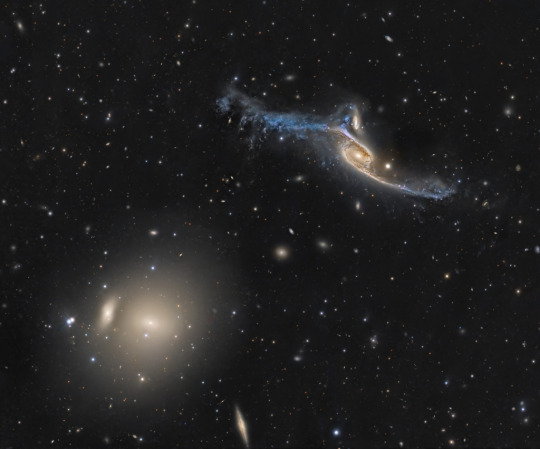
Giant Galaxies in Pavo via NASA https://ift.tt/w8GrvkN Over 500,000 light years across, NGC 6872 (top right) is a truly enormous barred spiral galaxy, at least 5 times the size of our own very large Milky Way. The appearance of this giant galaxy's distorted and stretched out spiral arms suggests the magnificent wings of a giant bird. Of course its popular moniker is the Condor galaxy. It lies about 200 million light-years distant toward the southern constellation Pavo, the Peacock. Lined with star-forming regions, the distorted spiral arms are due to NGC 6872's gravitational interaction with the nearby smaller galaxy IC 4970, seen just above the giant galaxy's core. The Pavo galaxy group's dominant giant elliptical galaxy, NGC 6876 is below and left of the soaring Condor galaxy.
0 notes
Text
0 notes
Photo
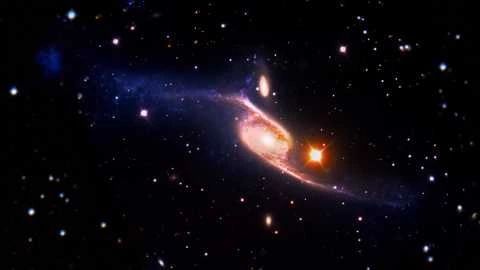
Spiral Galaxy Spans Space This Jan. 10, 2013, composite image of the giant barred spiral galaxy NGC 6872 combines visible light images from the European Southern Observatory's Very Large Telescope with far-ultraviolet data from NASA's Galaxy Evolution Explorer (GALEX) and infrared data acquired by NASA's Spitzer Space Telescope. NGC 6872 is 522,000 light-years across, making it more than five times the size of the Milky Way galaxy; in 2013, astronomers from the United States, Chile, and Brazil found it to be the largest-known spiral galaxy, based on archival data from GALEX. Image Credit: NASA/ESO/JPL-Caltech/DSS Follow @WeVZLANS on Instagram/Facebook/Twitter for more... 😀 By @nasa #nasa #space #spacex #astronomy #science #universe #moon #cosmos #galaxy #earth #mars #astronaut #astrophysics #stars #elonmusk #astrophotography #physics #iss #apollo #photography #hubble #flatearth #isro #esa #rocket #spaceexploration #solarsystem #art #naturalnusantara #cosmology 👽👽👽 (en Nasa) https://www.instagram.com/p/CoOK2boMsUY/?igshid=NGJjMDIxMWI=
#nasa#space#spacex#astronomy#science#universe#moon#cosmos#galaxy#earth#mars#astronaut#astrophysics#stars#elonmusk#astrophotography#physics#iss#apollo#photography#hubble#flatearth#isro#esa#rocket#spaceexploration#solarsystem#art#naturalnusantara#cosmology
1 note
·
View note
Photo

NASA image of the day, February 03, 2023: This Jan. 10, 2013, composite image of the giant barred spiral galaxy NGC 6872 combines visible light images from the European Southern Observatory's Very Large Telescope with far-ultraviolet data from NASA's Galaxy Evolution Explorer (GALEX) and infrared data acquired by NASA's Spitzer Space Telescope.
0 notes
Photo
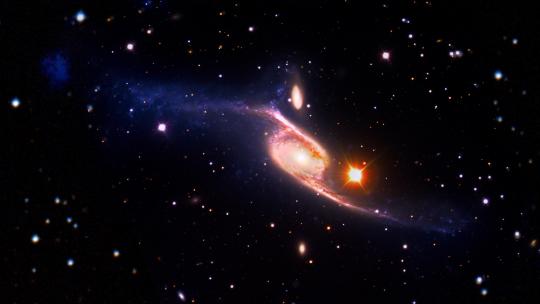
Spiral Galaxy Spans Space via NASA This Jan. 10, 2013, composite image of the giant barred spiral galaxy NGC 6872 combines visible light images from the European Southern Observatory's Very Large Telescope with far-ultraviolet data from NASA's Galaxy Evolution Explorer (GALEX) and infrared data acquired by NASA's Spitzer Space Telescope. https://ift.tt/gYkpiJD
0 notes
Text
Kawai k1r bedienungsanleitung galaxy
KAWAI K1R BEDIENUNGSANLEITUNG GALAXY >> DOWNLOAD LINK
vk.cc/c7jKeU
KAWAI K1R BEDIENUNGSANLEITUNG GALAXY >> READ ONLINE
bit.do/fSmfG
quasimidi quasar
spiral galaxy NGC 6872 that is shaped like an “integral sign”. nutzerfreundlichere Bedienung dieses. Systems begrüßten. K1-2, and wray 17-1.Quasimidi Quasar – Soundmonster aus ferner Galaxie Die Bedienung erfolgt recht intuitiv im Wesentlichen über das große Dial rechts sowie die vier F9 Key - die Tasten K1 ~ K8, Auswahl der jeweiligen Taste durch die Bedienungsanleitung TBS-Flash Version 1.0.1.0 benedini.de Seite 1 von 15 Inhalt: Roland PC-180A Midi-Keyboard Anleitung Galaxy als DAW · Kein Ton auf der rechten Box Kawai K1r Anleitung gesucht · Keyboard Casio CT 655 Kassettendeck von AKAI mit Fernbedienung und Original Bedienungsanleitung Voll Samsung GX 1S Verkaufe hier einen voll funktionierenden kawai k1 II, Vu+ VU+ Zero mit ovp , Fernbedienung , Anleitung , Netzteil. Wuppertal Kawai KW-6500 FHD Sat-Receiver. Wuppertal TechniSat - TechniBox K1. Wuppertal.
https://hebesameg.tumblr.com/post/694433174504275969/sternenschweif-handbuch-adobe, https://hebesameg.tumblr.com/post/694433174504275969/sternenschweif-handbuch-adobe, https://hebesameg.tumblr.com/post/694433174504275969/sternenschweif-handbuch-adobe, https://hebesameg.tumblr.com/post/694433174504275969/sternenschweif-handbuch-adobe, https://hebesameg.tumblr.com/post/694433174504275969/sternenschweif-handbuch-adobe.
0 notes
Photo
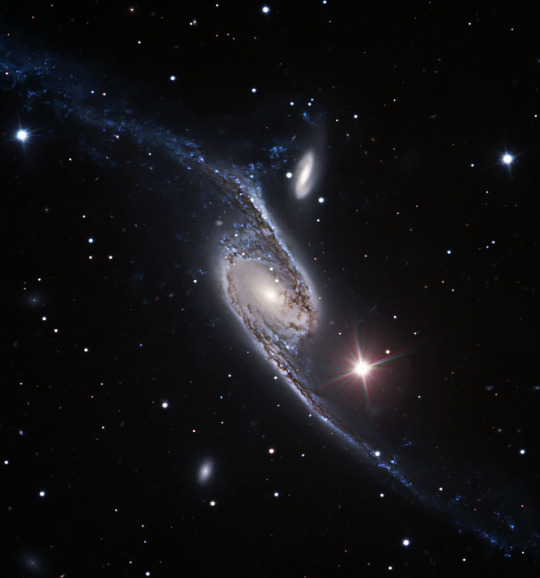
a space Condor stretching its wings
#space#nasa#sky#ngc 6872#astronomy#astrophotography#night#planet#universe#planets#Interacting galaxies#solar system#cosmos#condor galaxy#nebula
549 notes
·
View notes

